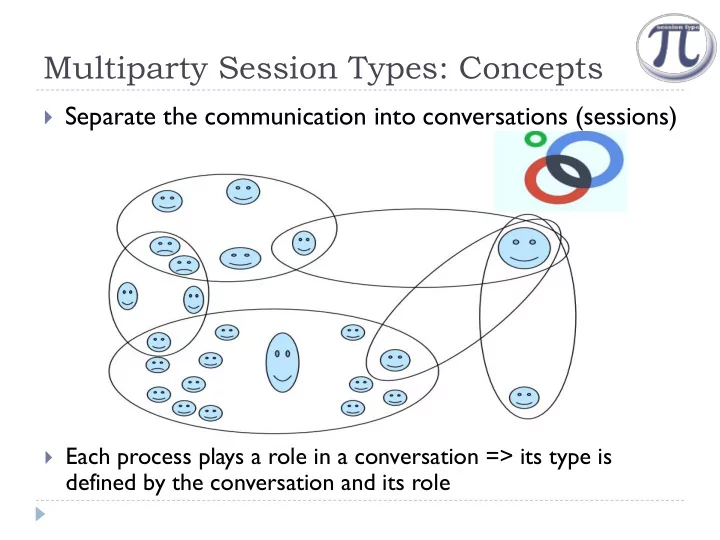

Multiparty Session Types: Concepts Separate the communication into conversations (sessions) Each process plays a role in a conversation => its type is defined by the conversation and its role
Evolution Of MPST Binary Session Types [THK98, HVK98] Multiparty Session Types [POPL’08] A Theory of Design-by-Contract for Distributed Multiparty Interactions [ Concur’11] Monitoring Networks through Multiparty Session Types [TGC’12] Multiparty Session Types Meet Communicating Automata [ESOP’12, ICALP’13] Network Monitoring through Multiparty Session Types [FMOODS’13] Local Verification of Global Protocols, Practical Interruptible conversations [RV’13]
Case Study: OOI OOI requirements applications written in different languages, running on heterogeneous hardware in an asynchronous network. different authentication domains, external untrusted applications requires correct, safe interactions
Session Types for Monitoring Distributed monitoring attach a monitor to each application the monitor checks messages w.r.t specification ensures interoperablity
Session types for monitoring Adapting MPST theory to monitoring Principals Developers design protocols in a dedicated language - Scribble Well-fomedness is checked by Scribble tools Protocols are projected into local types Local types generate monitors
OOI Requirements - revisited Communication based on various protocols General protocol verification monitor Heterogeneous systems protocol description language - Scribble Different authentication domains distributed monitoring Can we guarantee safety properties a theory for network monitoring with soundness theorems
www.scribble.org
Scribble Community Webpage: www.scribble.org GitHub: https://github.com/scribble Tutorial: www.doc.ic.ac.uk/~rhu/scribble/tutorial.html Specification (0.3) www.doc.ic.ac.uk/~rhu/scribble/langref.html
Two Buyer Protocol in Scribble
Protocol Well-fomedness (choice)
Buyer: A local projection
The whole picture
It’s Demo time Internal" CC Runtime component monitoring [DEMO]
More advanced protocols https://confluence.oceanobservatories.org/display/syseng/ CIAD+COI+OV+Governance+Framework Higher-level" application protocols Composition of RPC calls Negotiation protocol
Application-level service call composition
Scoping
Scoping
Agent Negotiation Provider and Consumer agents negotiate a Service Agreement Proposal https://confluence.oceanobservatories.org/display/syseng/CIAD+COI +OV+Negotiate+Protocol
Negotiation protocol in Scribble
Negotiation protocol in Scribble
Governance Framework
Scribble annotations … The monitor passes {assertion: payment>=1000} offer(payment: int) from C to I; {‘type’: param , …} … to the upper layers … @{deadline: 5s} Upper layers recognize offer(payment: int) from C to I; and process the … annotation type or … discard it @{commitment: create(C, I, payment)} offer(payment: int) from C to I; …
A theory for network monitoring Formalise MPST -monitoring and asynchronous networks. Introduce monitors as first-class objects in the theory Justify monitoring by soundness theorems. Safety monitors enforces specification conformance. Transparency monitors does not affect correct behaviours. Fidelity correspondence to global types is maintained.
Multiparty Sessions for Runtime Monitors
Formal Semantics processes 𝑄 located at principals α Abstracts local applications router 𝑠 abstracts network routing information updated on-the-fly
Formalism: Monitor Specifications Monitors Monitors are introduced as component of monitored networks
Satisfaction
Results (Safety)
Results (Transparency)
Results (Fidelity)
Summary Having a context allows to control the communication Having granularity allows to specify constraints on the interactions Early error detection is much cheaper High-level policies on top of protocol verification Good abstraction means easy programming – you program with send and receive (no threads, sockets, channels)
References http://www.youtube.com/watch?feature=endscreen&v=mr Eiwd9Buxk&NR=1 https://confluence.oceanobservatories.org/download/attac hments/18351011/OOI+CyberInfrastructure+- +Next+Generation+Oceanographic+Research- lowres.pdf?version=1&modificationDate=1246912767000 http://icmrg.herokuapp.com/
Recommend
More recommend